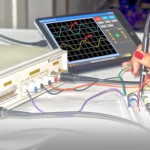Technologies are changing with a high pace, Devices like DSP Processor, FPGA, MicroController and ASIC are available. Based on technology, architecture, price, quantity and usage different devices can be used in the different application. Here we will discuss the effect of using FPGA – Field Programmable Gate Array on Test and Measurement Instruments in brief:
Direct benefits of using FPGA-based Test and Measurement equipment
We may classify Test and Measurement equipment broadly in two categories, first is for general purpose usage like education / Training institutes and second for the industrial purpose. In both cases the basic requirement like compact design, performance and cost matter a lot in all T & M equipment. User defined flexible design and virtual instrumentation where the functionality of an instrument being determined by programming / software can add an extra for both end users as well as for the designers.
Now a day powerful FPGAs are equipped to provide higher design flexibility, higher precision processing, high-density algorithm, lower power requirement, and overall lower cost which is some of the benefits of FPGA-based T & M equipment.
The true parallelism, a unique feature of FPGA device exceed the computing power of Digital Signal Processors (DSPs) by breaking the paradigm of sequential execution and allows multiple clock domains to be incorporated; Single device is now much powerful and capable to perform simultaneous operation of multi-instrument to directly benefit user to have flexible, compact, light weight, precise, multi-featured instrument at overall low cost.
Problems faced by engineers/users while moving to FPGA-based T&M?
As far as technology is the concern, I don’t think end user has to face any problem while moving to FPGA-based T & M, Design Engineers may have to work a little bit to gain knowledge related to new technology, tools and devices.

Does the traditional FPGA value proposition of reduced time-to-market, lower development cost (total), and flexibility completely apply here in T&M for the user?
Multifunctional and Programmable Instruments are based more or less on FPGA value proposition. By using FPGA in test and measurement, we can make functional enhancements without spending time in redesigning hardware or modifying the board layout and thus reduced time-to-market, low development cost as compared to ASIC (Application Specific Integrated Circuit) based system and flexibility by re-programming apply for the end user in T & M.
Find out if FPGA in the test is good for some, not worth it for the rest
FPGA in test depends on the feature and functionality of T & M equipment required by the end user.
On one side, FPGA in the test is good for the system with multi-channel parallel functionality and narrow bandwidth. FPGA based test can keep up with future modifications that might be necessary.
On the other side, the system with just one or two channels and of higher bandwidth (GHz), the cost of FPGA and thus the cost of the system for the end user can quickly exceed and it may not be worthwhile as compared to ASIC.



